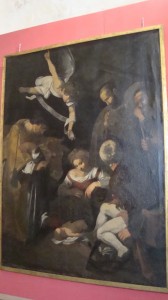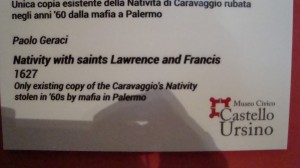by Amineddoleh & Associates LLC | Dec 16, 2015 |
It was reported last week that a facsimile of Caravaggio’s Nativity with San Lorenzo and San Francesco (also known as The Adoration) will be placed in the Oratio of San Lorenzo, the oratory where the painting on which it was copied was stolen in October 1969. After being displayed for about three-and-a-half centuries in Palermo, Sicily, the Baroque masterpiece was stolen and has not been seen since. Theories about its eventual fate (relocation or destruction) have circulated for years, but nothing is definitively known about its whereabouts except that it is believed that the mafia played a role in the disappearance. The high-resolution digital copy was welcomed last weekend by Italy’s head of state, Sergio Mattarella (a former judge whose brother was killed by the mafia).
But where is the original painting? Sadly, many stolen works are never recovered. As more time passes, it becomes more and more unlikely that art objects will ever be recovered. Some works are intentionally or accidentally destroyed. Works can sometimes be inadvertently damaged, however some thieves intentionally destroy their loot to avoid detection or culpability. For example, thieves and their accomplices have burned works, thrown them in the river, and shredded them in garbage disposals. In regards to recovery, law enforcement agents state that art thieves are almost never caught, with the FBI recovery success “below 10 percent.”[1] (Others opine that only 2-5% of art is ever recovered.) Interestingly, the values of works on the black market are drastically reduced, perhaps fetching about 10% of its estimated value on the legal market.
In the case of Caravaggio’s Nativity with San Lorenzo and San Francesco, a high-quality copy was placed in the original location of the stolen painting. High-quality replicas may soon play increasingly significant roles in art history as 3-D imaging is now being used to record details about at-risk objects in conflict regions, such as ISIL territories in Iraq and Syria or pillaged areas in India. Emerging imaging technology will help to fill in gaps and prevent loss of information due to destruction and theft of art objects.


(A copy that I was lucky enough to see this summer in Catania, Sicily.)
[1] http://www.bloomberg.com/news/articles/2015-06-15/what-happens-to-stolen-art-after-a-heist-
by Amineddoleh & Associates LLC | Dec 7, 2015 |
Partner Leila A. Amineddoleh will be discussing art law and its intersections with intellectual property law at the International Intellectual Property Society’s New York meeting. The event will explore issues related to art theft, artists’ rights, authentication, and even touch upon antiquities looting. After the presentation, the group will be hosting a holiday party at Smith, Gambrell & Russell, LLP. Find additional information below.
ART LAW
The IIPS is pleased to announce that our December 8th meeting will feature a presentation on Art Law by Leila Amineddoleh.
There will be a Holiday Party with hors d’oevres and open bar after the presentation
Join us for a great presentation at a festive meeting.
WHEN: Tuesday, December 8, 2015, from 6:00 to 8:00 pm
WHERE: Smith, Gambrell & Russell, LLP,
1301 Avenue of the Americas, 21st Floor
(6th Ave. between 52nd and 53rd)
(subway stops: F and M at 47th-50th (Rockefeller Center), and M at 53rd between 5th and 6th)
RSVP: Please RSVP to iipsny@yahoo.com no later than Monday, December 7, 2015
CLE: Two (2.0) hours – New York and New Jersey
FEE: The meeting fee is $30 for non-members or you may become a member bycompleting the membership form and submitting the September 2015 – June 2016 annual fee of $100 ($25 for law students). Fees may be paid by cash, check or credit card at the meeting or pay by credit card here.
About our December presenter
Leila A. Amineddoleh
Ms. Amineddoleh specializes in art, cultural heritage, and intellectual property law. Ms. Amineddoleh began her career as an associate at Fitzpatrick, Cella, Harper & Scinto, where she specialized in high-stakes intellectual property litigation, and then worked Of Counsel at Lombard & Geliebter where she founded the firm’s art law group. Ms. Amineddoleh is involved in all aspects of due diligence and litigation, and has extensive experience in arts transactional work. She has represented major art collectors and dealers in disputes related to multi-million dollar contractual matters, art authentication disputes, international cultural heritage law violations, the recovery of stolen art, and complex fraud schemes. She also works with artists and entrepreneurs to protect their intellectual property and artistic rights.
Ms. Amineddoleh teaches International Art & Cultural Heritage Law at Fordham University School of Law and St. John’s University School of Law. Ms. Amineddoleh also served as the Executive Director of the Lawyers’ Committee for Cultural Heritage Preservation from 2013-2015. She is also a musician and regularly performs the piano in and around New York City.
Ms. Amineddoleh received her Juris Doctor degree from Boston College Law School. In law school, she was an Editor of the Intellectual Property and Technology Forum online journal. Prior to law school, Ms. Amineddoleh received her undergraduate degree in economics from New York University. Leila is admitted to the bar in New York and New Jersey.
Ms. Amineddoleh is a member of Art Law Committee of the Bar of the City of New York, and served as Legal Chair of SAFE (Saving Antiquities for Everyone), 2009-2010.
Leila is a frequent lecturer and author. Ms. Amineddoleh recently lectured on “Art Crime: Thefts, Forgeries, Vandalism, and More,” Brooklyn Brainery (November 2015), and as an Art crime consultant for Museum Hack, providing a training session to the museum group (Summer 2015). Some of Leila’s more recent publications include “Purchasing Art in a Market Full of Forgeries: Risks and Legal Remedies for Buyers,” International Journal of Cultural Property, Vol. 22, Issue 2-3 (Fall 2015);” Can the Market Help Preserve Antiquities?,” Wall Street Journal (August 27, 2015); “The British Museum Should Return the Parthenon Marbles to Greece,” Forbes (December 2014); and “Family Law: Artworks in Dispute,” Boston Bar Association Newsletter (Fall 2014).
We hope you will be able to join us and, as always, welcome your questions, comments, and any suggestions you may have for topics or speakers of interest for future IIPS programs.
Kind regards,
John S. Sensny
IIPS Secretary

